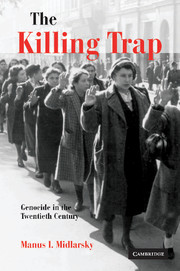Book contents
- Frontmatter
- Contents
- Preface
- PART I Introduction
- PART II Explaining perpetrators: theoretical foundations
- PART III The theory applied
- PART IV Victim vulnerability: explaining magnitude and manner of dying
- 10 Raison d'état, raison d'église
- 11 Cynical realpolitik and the unwanted
- 12 High victimization: the role of realpolitik
- 13 Inequality and absence of identification
- 14 On the possibility of revolt and altruistic punishment
- PART V Exceptions
- PART VI Conclusion
- References
- Index
14 - On the possibility of revolt and altruistic punishment
Published online by Cambridge University Press: 22 September 2009
- Frontmatter
- Contents
- Preface
- PART I Introduction
- PART II Explaining perpetrators: theoretical foundations
- PART III The theory applied
- PART IV Victim vulnerability: explaining magnitude and manner of dying
- 10 Raison d'état, raison d'église
- 11 Cynical realpolitik and the unwanted
- 12 High victimization: the role of realpolitik
- 13 Inequality and absence of identification
- 14 On the possibility of revolt and altruistic punishment
- PART V Exceptions
- PART VI Conclusion
- References
- Index
Summary
The preceding chapter detailed the impact on victim survival of inequality and identification among the victims. That chapter also examined identification between the victims and potential non-Jewish helpers – how that identification affected the differential likelihood of early death at the hands of the Nazis, or salvation from it. Now I examine the impact of identification not on the likelihood of death and its timing, but on the manner of dying. Why did the Warsaw ghetto end in a massive rebellion in which the remnants of the Jewish population chose to go to their deaths fighting, while a neighboring large Jewish ghetto, that of Łódź, exhibited virtually no sign of revolt, not even at the very end? And an intermediate case, that of Vilna, demonstrated an intent to revolt by a group of organized youth, but was persuaded to abandon that alternative when faced with the unique political circumstances of the moment. As we shall see, altruistic punishment was a major unifying factor in the successful organization of the Warsaw ghetto revolt.
Łódź
Ordered to be established on February 8, 1940, by the Łódź chief of police, SS Brigadenführer Johannes Schäfer, the Łódź ghetto was the oldest of the large Jewish ghettos in Poland. It was located in the Warthegau, a portion of prewar Poland annexed to the Reich after the Polish defeat of 1939. This most westerly of the large Jewish ghettos, therefore, was to be a major recipient of Western Jews deported from the old Reich, Czechoslovakia (principally Prague), and Austria (mostly Vienna).
- Type
- Chapter
- Information
- The Killing TrapGenocide in the Twentieth Century, pp. 287 - 306Publisher: Cambridge University PressPrint publication year: 2005



